Drawing of Pencils and Crayons
Recommended Drawing Pencils for Realistic Drawing (and Pencil Grades Demystified!)
All drawing pencils feel different to work with, and have unique properties that determine how your drawing will look. In this guide I will introduce you to the most common pencils used for realistic drawing, discuss the ones I use most often in my drawing tutorials (and why), and recommend high quality brands for you to try.
First, to address the elephant in the room: What drawing pencils should you use for realistic drawing?
If you are a beginner, I recommend that you start with graphite pencils. T hey are some of the smoothest and most easily erasable pencils to draw with, making them excellent for confidence-building when you're learning to draw.
With some experience you may choose to graduate to charcoal pencils, which require more technical skill to use effectively, but have their advantages over graphite. Read on to discover the differences between graphite and charcoal pencils, the advantages and disadvantages of each, and which brands I recommend. I'll also demystify pencil grades!
Graphite Pencil Guide
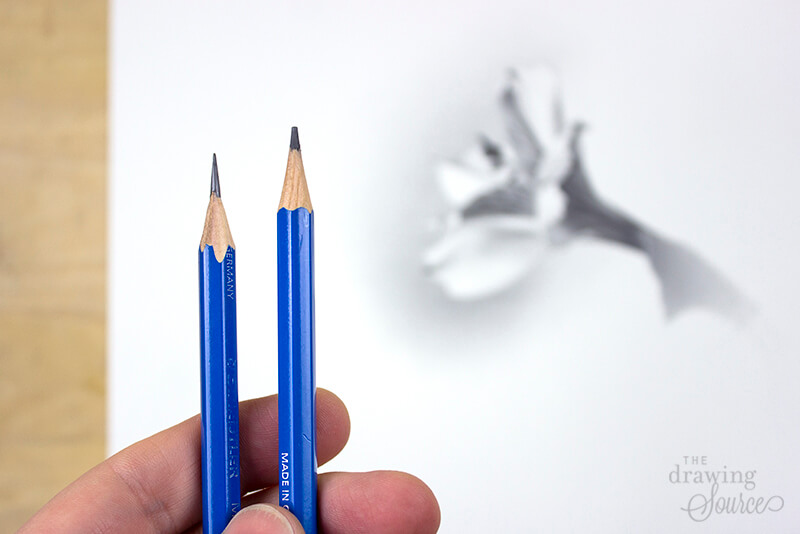 Pictured above: Staedtler Mars Lumograph Graphite Pencils
Pictured above: Staedtler Mars Lumograph Graphite Pencils
Graphite pencils come in a series of 'hardnesses', or 'grades', ranging from 9B (the softest) to 9H (the hardest).
The full range of graphite drawing pencils looks something like this:
9B, 8B, 7B, 6B, 5B, 4B, 3B, 2B, B, HB, F, H, 2H, 3H, 4H, 5H, 6H, 7H, 8H, 9H
The range varies slightly, depending on the brand. The grades above (and below) reflect the range of Staedtler Mars Lumograph graphite pencils (my preferred brand).
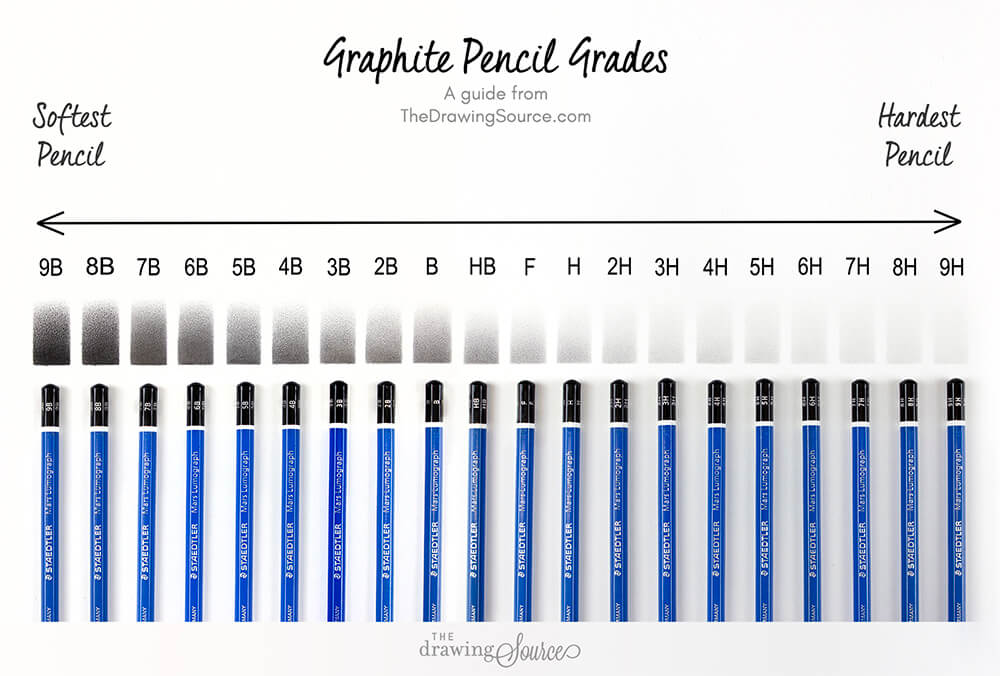 Pictured above: Staedtler Mars Lumograph graphite pencils
Pictured above: Staedtler Mars Lumograph graphite pencils
Why are pencil grades important?
Because the grade, or the hardness/softness of a pencil, determines the range of values and type of line that the pencil can create. Let's begin with the range of values:
If you picture a full value range (from white to pitch black), each pencil grade can create a segment of that value range.
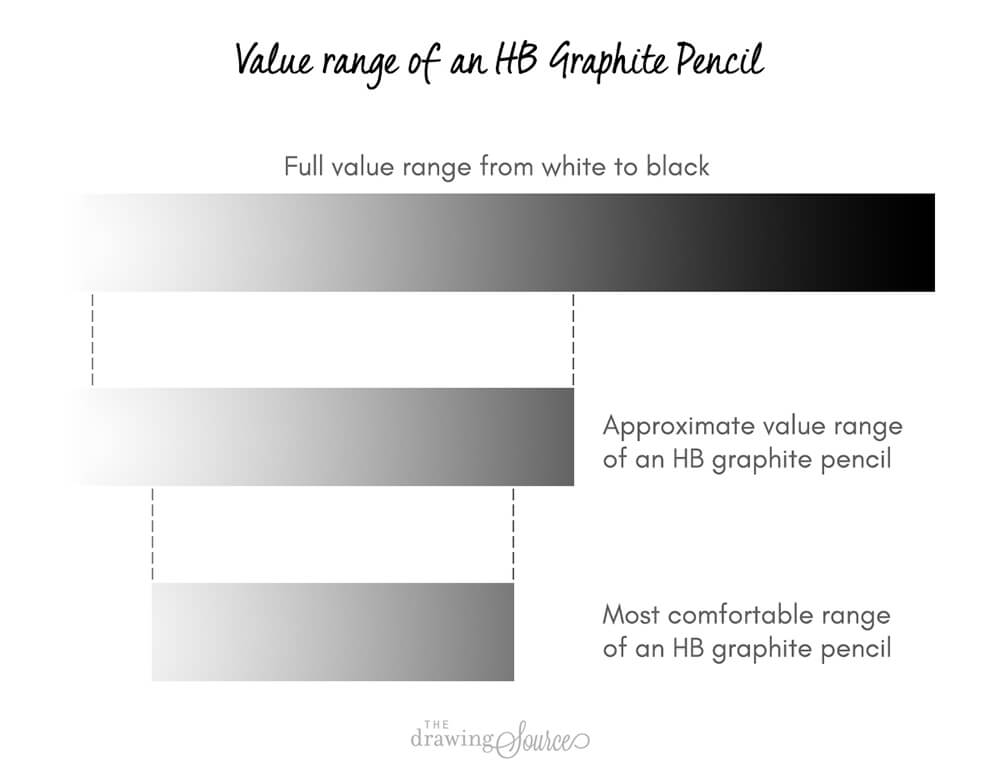
In the diagram above, you can see that the HB pencil can create a certain segment of values. Within its value range is the 'most comfortable' range that it can create. This means that you can extend its value range by using a kneaded eraser to lighten values, or layering your pencil marks to darken values, but it will take more effort to do that than to simply use a pencil that comfortably creates the value that you need.
The harder the pencil, the lighter the range of values that it creates.
The softer the pencil, the darker the range of values that it creates.
(This is the case for charcoal as well as graphite.)
As you can see in the image below, the darkness of graphite pencils varies from very light grey (9H) to almost pitch black (9B).
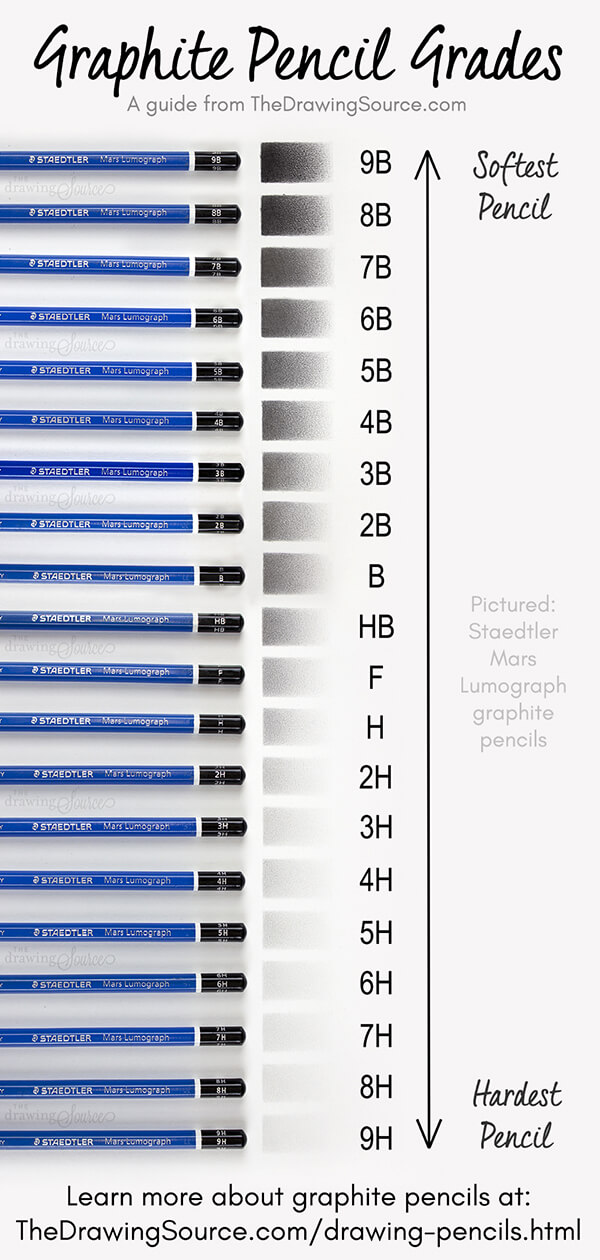
Let's compare the value ranges of two more graphite pencil grades. In the image below, the top gradation was drawn with a 2H graphite pencil. It ranges from the darkest possible value the 2H can create to the lightest possible value that it can create.
The bottom gradation was drawn with a 4B graphite pencil, and ranges from the darkest possible value the 4B can create to the lightest value it can create. (I used Staedtler Mars Lumograph graphite pencils for both gradations.)
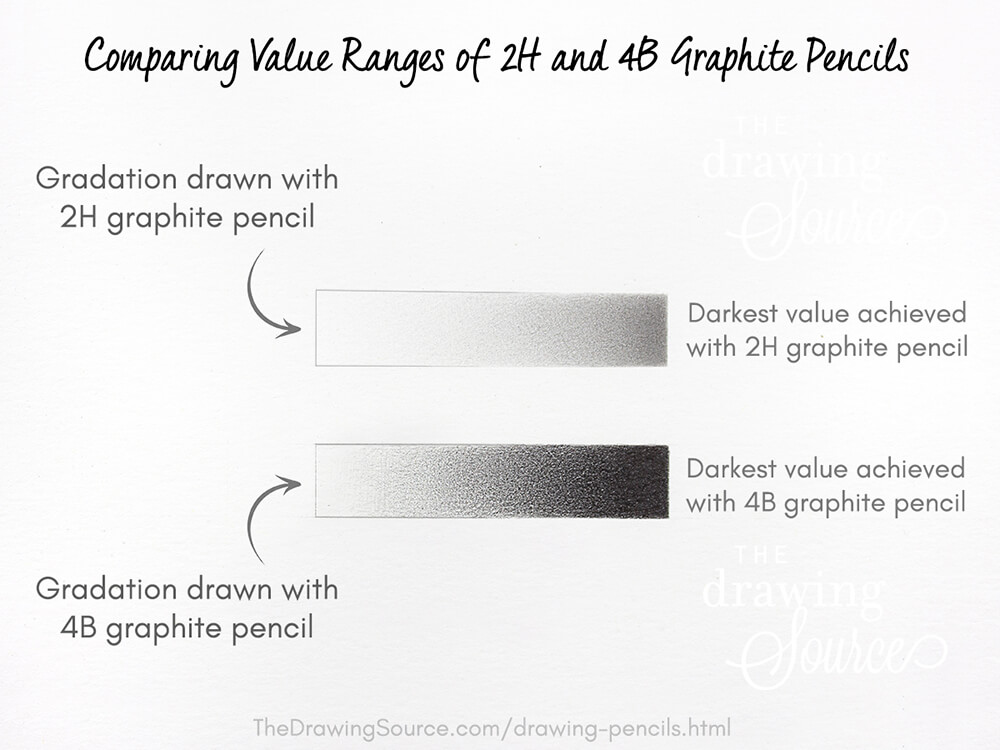
How do these gradations compare?
First, notice the vast difference in the range of values created by the 2H and 4B. The 2H can comfortably create from a value 2 to a value 3 or 4 on the value scale, while the 4B can create from a value 6 through 8. I had to use my kneaded eraser to create the lighter values of the 4B gradation, while it was almost effortless to use the 2H to gradate into the white of the paper. Notice how much smoother the 2H gradation appears as well, while you can see more of the paper texture in the 4B gradation.
![]()
B O N U S : What grade of pencil should you draw with?
Find out in this free downloadable guide!
(Plus, access the Free Members-Only Drawing Resource Library, and receive a weekly newsletter.)
![]()
How does the grade of a drawing pencil affect line quality?
The hardest pencils create sharper, lighter, thinner lines, while the softest pencils create softer, darker, thicker lines. (Of course, this depends on the sharpness of your pencil as well, but generally speaking - it is much easier to create a sharper line with a hard pencil, and a softer line with a soft pencil.)
Do you need the whole range of graphite pencils, from 9H to 9B?
No, it's not a necessity, but a matter of personal preference and skill level.
When I work with graphite, I usually have an HB, 2B, and a 4B. On the occasion that my drawing requires a very dark value, I may also use a 6B (though I try to avoid them, as the darker the graphite pencil, the more it will reflect light and produce glare - but I'll discuss that in a later section of the article).
If you are new to drawing and are developing the sensitivity of your hand, you may want to add a few harder pencils, such as a 2H, to make it easier to draw the lightest values in your drawing.
Types of Graphite Drawing Pencils
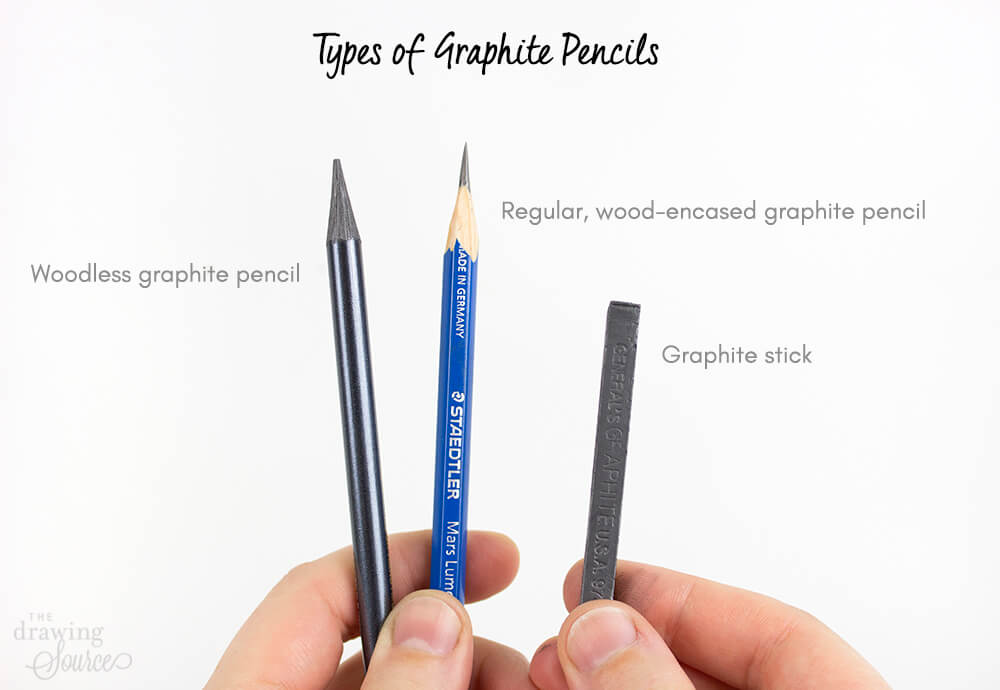
Graphite pencils come in several forms.
- They can be encased in wood - these are the most common form, pictured above.
These graphite pencils are made of a mixture of graphite powder and clay filler. The ratio of the two determines what grade, or hardness, the pencil is. The more filler - the harder the pencil. - They can be in pencil form but "woodless"
- They can be in stick form
Brands of graphite: I tend to use Staedtler Mars Lumograph pencils, but other brands such as Derwent and Faber-Castell work just fine as well.
Working with Graphite Pencils
The application of graphite on paper is smoother than charcoal, and easier to gain control of. It can be very comfortable and enjoyable to work with, especially when paired with a smooth drawing paper .
Because of this, I often recommend that beginners draw with graphite to build confidence and experience before moving on to charcoal pencils.
Keep in mind that graphite has a metallic sheen.
The shine, or glare, can be very apparent when you stand at an angle to a picture drawn in graphite, such as the one below:
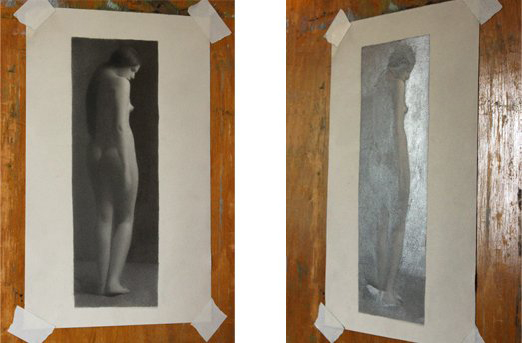
As you can see, the sheen becomes more apparent where there are darker values. So, the darker the tones in your drawing, the more they will reflect light and produce glare. This can be particularly irksome when trying to photograph graphite drawings.
While there are ways to minimize graphite glare, it is ultimately an inescapable quality of the medium. If you experiment with graphite and find that the glare is too much for you, don't fight it. You will lose. If it bothers you too much, just don''t use it! Instead, use one of the many drawing pencils available to you that don''t naturally have a shiny, metallic quality.
(I actually abandoned the above drawing because I was frustrated with the glare. Lesson learned! Graphite is better used for lighter value drawings. Notice that the lightest areas in the drawing above are not producing any glare!)
Always strive to work with your materials, not against them. This will result in a much more enjoyable drawing process for you, as well as a better end result!
Tips for Minimizing Graphite Glare
- As you can see in the image above: the lighter the area, the less glare will be produced. Choose to work in graphite when you are drawing a lighter image.
- If you must use graphite for the dark areas of your drawing, instead of pressing harder with the pencil, slowly layer the graphite to darken the area.
Charcoal Pencils
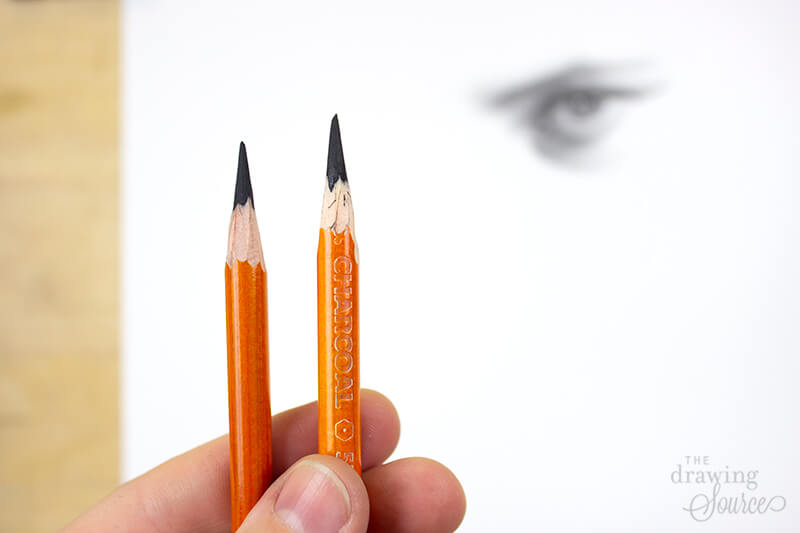 Pictured above: Generals Charcoal Pencils
Pictured above: Generals Charcoal Pencils
Charcoal pencils consist of charcoal powder mixed with a gum binder. This concoction is then compressed into sticks or encased in wood. As with graphite, the amount of binder used regulates the degree of hardness of the pencil. The more binder used, the harder the grade of the pencil.
The hardness of charcoal pencils usually ranges from HB to 6B (from hardest to softest). A few brands go a step further and make 2H pencils, but I personally don''t use them (I find that they often scratch my drawing paper rather than leave a smooth mark).
If you are going to work with charcoal pencils, I suggest that you buy an HB, 2B, 4B and a 6B, by a brand called General's. (Read about what I look for in charcoal pencil brands and how to compare them in this article!)
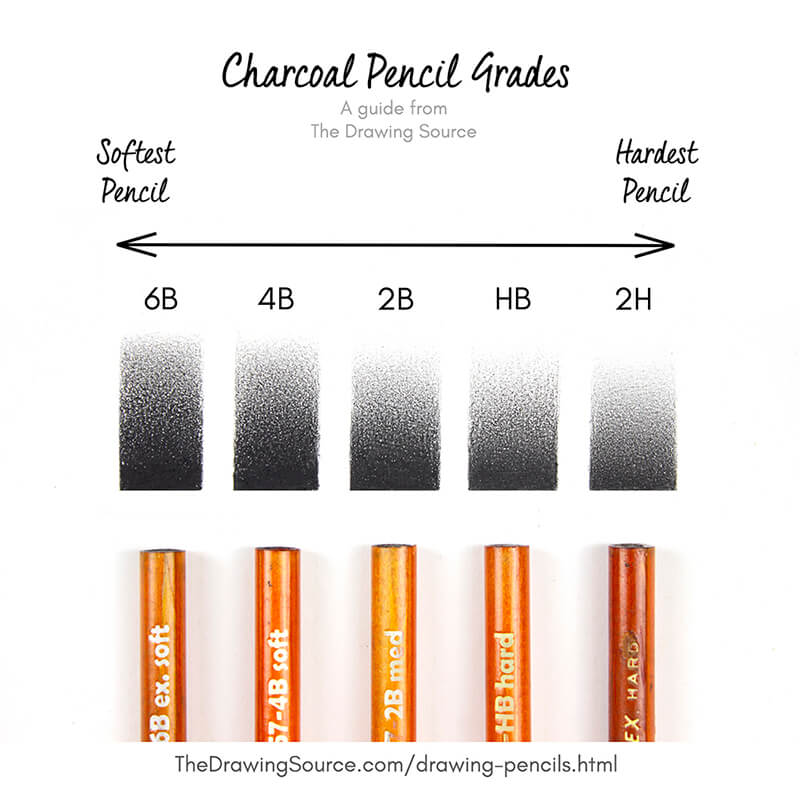
You may come across charcoal pencils by other brands that are classified simply as 'soft, medium, and hard' or 'light, medium, an dark'. I don't use these because I find that pencils using the 'soft, medium, and hard' classifications tend to be less consistent and predictable than the General's pencils.
General's pencils also have a wider range. For example, a General's HB tends to be harder (and therefore easier to create lighter marks with) than a 'hard' charcoal pencil. If you must use charcoal drawing pencils labelled as 'soft, medium and hard':
The 'soft' pencil is comparable to a 6B
The 'medium' pencil is comparable to a 2B or 4B
The 'hard' pencil is comparable to an HB
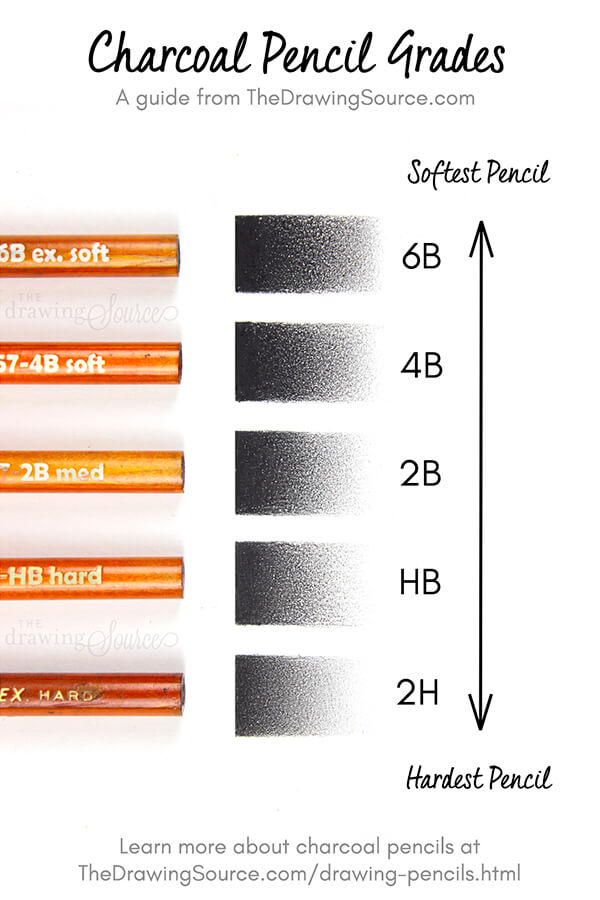
Willow and Vine Charcoal Sticks
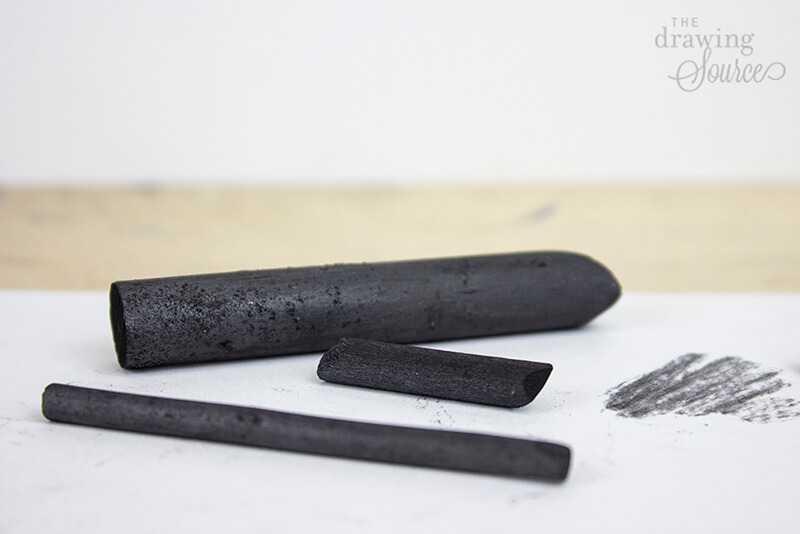 Vine charcoal sticks
Vine charcoal sticks
Literally burnt twigs, willow and vine charcoal sticks are uncompressed charcoal. As opposed to compressed charcoal (which is found in regular charcoal pencils), uncompressed charcoal is much softer, lighter, and easier to spread and erase. In fact, it lifts off the paper so easily that you really have to be careful not to disturb it!
Willow and vine charcoal sticks are particularly useful tools for filling in and evening out large value masses, especially when paired with a soft bristle brush. You can also use it to tone your own paper, as I did for the sketches below:
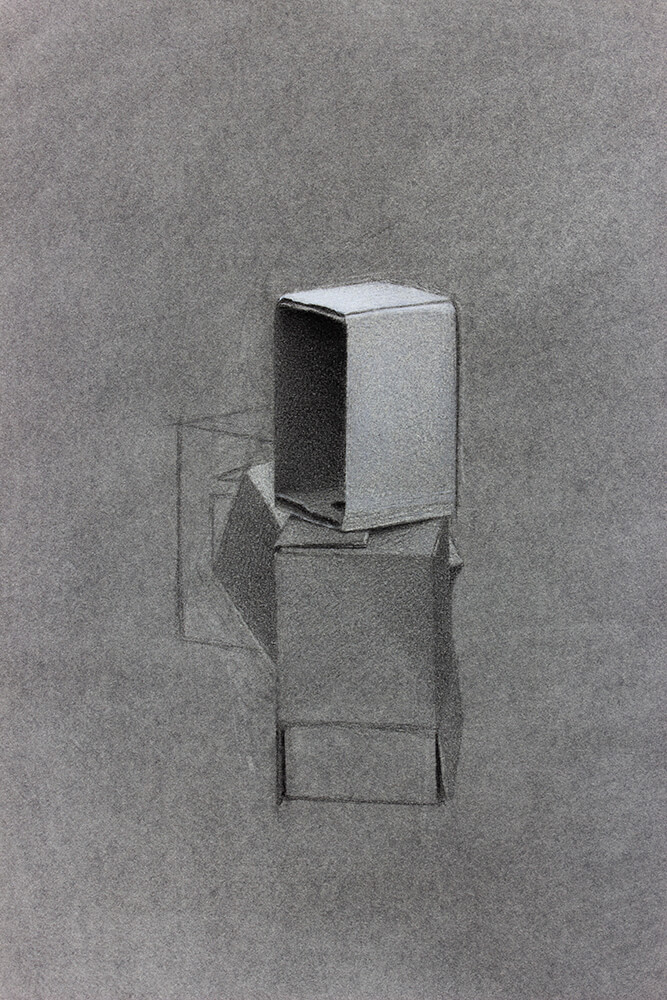
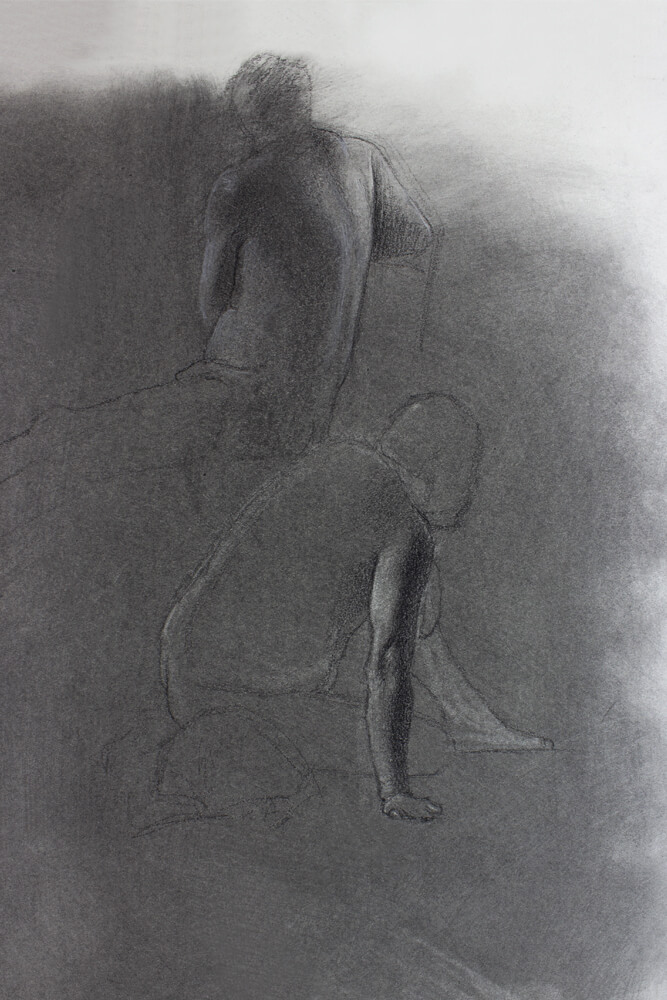
Above: sketches on toned paper using a combination of black and white charcoal drawing pencils.
Graphite vs. Charcoal
The drawing pencils that you choose depend on many factors. One pencil is not "better" than another: they all have different characteristics that are suitable for different kinds of drawings. You will learn to choose the right medium for your drawings as you experience the qualities of the different drawing pencils, and figure out what kind of drawing you want to create.
Having said that, here are some pro's and con's of graphite vs. charcoal:
Graphite
- (Pro) easier to work with because the application of graphite on paper is smoother than that of charcoal
- (Con) can reflect light, creating graphite glare or shine (causing values to appear lighter than they actually are)
- (Con) does not darken to pitch black as easily as charcoal
Charcoal
- (Con) requires more skill to work with (it is more difficult to draw light lines and smooth, even values with charcoal pencils)
- (Pro) absorbs light - no 'glare'!
- (Pro) darkens to a pitch black, allowing us to create a wider range of values and higher contrast images
- (Pro) versatile: can be combined with white charcoal
When to Use Charcoal Pencils:
- When you need a full range of values, from white to pitch black. Charcoal darkens to pitch black, allowing you to create a wider range of values in your drawing. Graphite simply does not darken to the same pitch black as charcoal does.
- When creating a 'low value key' drawing: a drawing where most of the values are between values 5 and 9 on the value scale.
- When you want to combine it with a white drawing pencil. Charcoal is a very versatile medium. It can be used by itself, or combined with a white drawing pencil to give your drawing different looks and variations in temperature. Here are three of my favorite techniques for combining charcoal with white.
- When you dislike the shine that graphite creates. Some artists love the graphite shine, others are neutral, and others quite dislike it. I personally don't love it, and usually only use graphite when creating drawings that consist mostly of lighter values.
When to Use Graphite Pencils:
- When creating a 'high key' drawing: a drawing that consists mostly of lighter values. As you saw earlier in the article, lighter values produce less graphite glare.
- When you want a smoother drawing experience. The application of graphite on paper is definitely smoother than that of charcoal. It is easier to draw lightly with graphite, and to shade smoothly and evenly. (You can certainly learn to do the same with charcoal, but it will take considerably more practice.)
Can you combine graphite and charcoal?
I see what you're thinking ... you want the best of both worlds! This is actually a common question that I receive.
Graphite and charcoal do not layer on top of each other very well. However, if you are careful, you can use graphite next to charcoal. For example, you can use graphite for lighter areas of your drawing, and create a subtle gradation that 'turns into' charcoal (again, not layering one on top of the other, but making sure that one is right next to the other).
This is an advanced technique that I suggest using once you are comfortable using graphite and charcoal drawing pencils separately.
Conclusion
The best way to get to know what drawing pencils you prefer is to work with both! An excellent exercise to compare the properties of these two pencil types is to draw the same subject matter using graphite and then charcoal. Why not do this with me in my Realistic Drawing 101 course, while learning the essential skills and concepts of realistic drawing?!
If you have any questions about these supplies, you are welcome to email me at marina@thedrawingsource.com
Happy Drawing!
![]()
![]()
B O N U S : What grade of pencil should you draw with?
Find out in this free downloadable guide!
(Plus, access the Free Members-Only Drawing Resource Library, and receive a weekly newsletter.)
![]()
Enjoyed this page? Please share it!
Share buttons and pinnable images below:
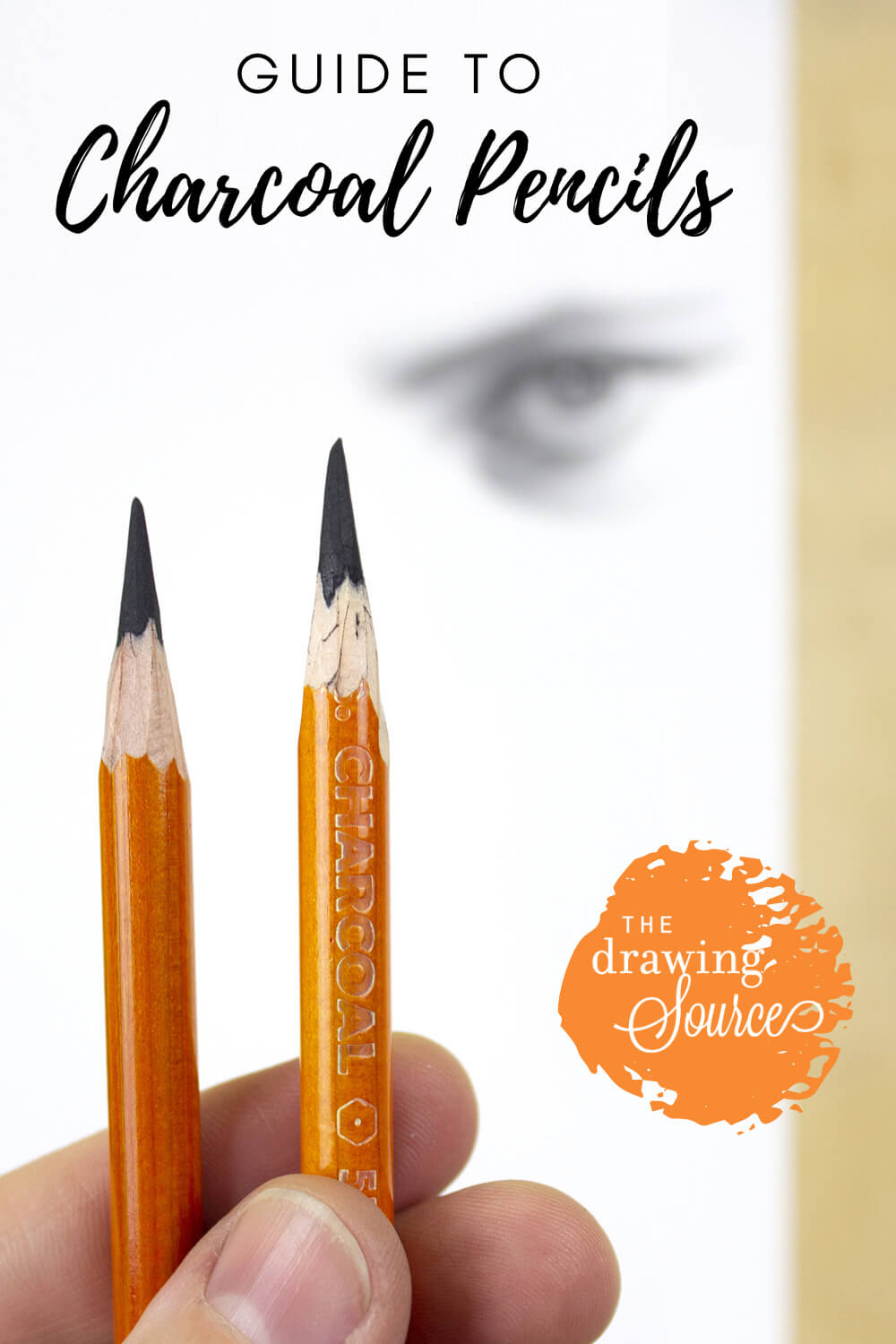
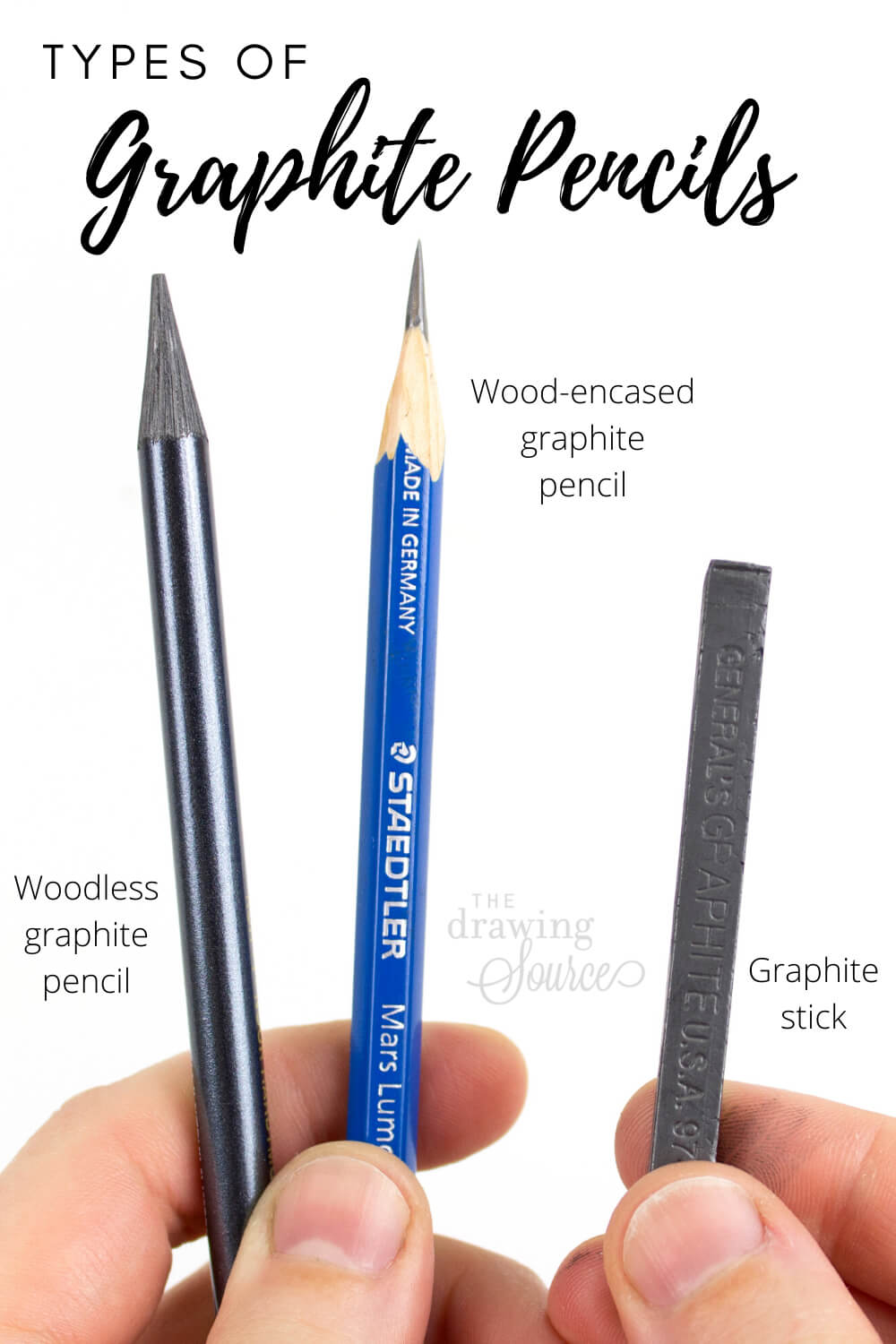
Related Pages
If you enjoyed this page on drawing pencils, you may also enjoy ...
How to Sharpen Drawing Pencils
How to Hold and Control Your Drawing Pencil
3 Ways to Use White Charcoal Pencils
How to Make Toned Paper
Return to Drawing Supplies from Drawing Pencils
Return to the Homepage from Drawing Pencils
Drawing of Pencils and Crayons
Source: https://www.thedrawingsource.com/drawing-pencils.html
0 Response to "Drawing of Pencils and Crayons"
Post a Comment